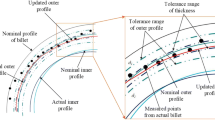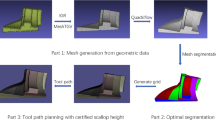Abstract
This paper addresses the problem of accuracy characterization and measurement point planning for 3-D workpiece localization in the presence of part surface errors and measurement errors. Two frame-invariant functions of the infinitesimal rigid body displacement are defined to quantify the localization accuracy required by manufacturing processes. Then, two kinds of frame-invariant indices are derived to characterize the sensitivities of the accuracy measures to the sampling errors at the measurement points. With a dense set of discrete points on the workpiece datum surfaces pre-defined as candidates for measurement, planning of probing points for accurate recovery of part location is modeled as a combinatorial problem focusing on minimizing the accuracy sensitivity index. Based on an interchange rule, a greedy algorithm is developed to efficiently find a near-optimal solution. It is also shown that if the number of the measurement points is sufficiently large, there is no need to optimize their positions. Example confirms the validity of the presented indices and algorithm.
Similar content being viewed by others
References
Ding, H., Zhu, L. M., Xiong, Z. H., A survey on coordinate measurement, geometric modeling and PR or NC code generation from measured data points, Chinese Journal of Mechanical Engineering, 2003, 39(11): 28–37.
Zhu, L. M., Xiong, Z. H., Ding, H. et al., A distance function based approach for localization and profile error evaluation of complex surface, Transactions of ASME, Journal of Manufacturing Science & Engineering, 2004, 126(3): 542–554.
Zhu, L. M., Ding, H., Application of kinematic geometry to computational metrology: distance function based heirarchical algorithms for cylindricity evaluation, International Journal of Machine Tools & Manufacture, 2003, 43(2): 203–215.
Li, Z., Gou, J., Chu, Y., Geometric algorithms for workpiece localization, IEEE Transactions on Robotics and Automation, 1998, 14: 864–878.
Sourlier, D., Bucher, A., Surface-independent, theoretically exact bestfit for arbitrary sculptured, complex, or standard geometries, Precision Engineering, 1995, 17: 101–113.
Forbes, A. B., Least-squares best-fit geometric elements, in Algorithms for Approximation II (ed. Mason, J. C., Cox, M. G.), London: Chapman and Hall, 1990, 311–319.
Hong, J. W., Tan, X. L., Method and apparatus for determining position and orientation of mechanical objects, U.S. Patent 5208763, 1990.
Yan, Z. C., Meng, C. H., Uncertainty analysis and variation reduction of three-dimensional coordinate metrology, International Journal of Machine Tools & Manufacture, 1999, 39: 1199–1261.
Yau, H. T., Uncertainty analysis in geometric best fit, International Journal of Machine Tools and Manufacture, 1998, 38: 1323–1342.
Murray, R. M., Li, Z., Sastry, S. S., A Mathematical Introduction to Robotic Manipulation, Boca Raton: CRC Press, 1994.
Wang, M. Y., Characterizations of localization accuracy of fixtures, IEEE Transactions on Robotics and Automation, 2002, 18(6): 976–981.
Chu, Y. X., Gou, J. B., Li, Z. X., Workpiece localization algorithms: performance and reliability analysis Journal of Manufacturing System, 1999, 18(2): 113–126.
Lin, Q., Burdick, J. W., Objective and frame-invariant kinematic metric functions for rigid bodies, International Journal of Robotics Research, 2000, 19: 612–625.
Wang, M. Y., Tolerance analysis for fixture layout design, Assembly Automation, 2002, 22(2): 153–162.
Soderberg, R., Carlson, J., Locating scheme analysis for robust assembly and fixture design, in Proc. of the ASME Design for Manufacture Conference, Las Vegas, Nevada, UAS, 1999.
Asada, H., By, A. B., Kinematic analysis of workpart fixturing for flexible assembly with automatically reconfigurable fixture, IEEE J. of Robotics & Automation, 1985, 1(2): 86–94.
Wang, M. Y., Pelinescu, D., Optimizing fixture layout in a point set domain, IEEE Trans. on Robotics and Automation, 2001, 17(3): 312–323.
Fang, K. T., Applied Multivariate Statistical Analysis (in Chinese), Shanghai: East China Normal University Press, 1989.
Zhu, L. M., Distance function-based models and algorithms for fitting of geometric elements to measured coordinate points, Postdoctoral technical report (No. 2002-2), School of Mechanical Science & Engineering, Huazhong University of Science & Technology, 2002.
Choudhuri, S. A., Demeter, E. C., Tolerance analysis of manufacturing fixture locators, Trans of ASME, Journal of Manufacturing Science & Engineering, 1999, 121(2): 273–281.
Rong, Y., Hu, W., Kang, Y. et al., Locating error analysis and tolerance assignment for computer-aided fixture design, International Journal of Production Research, 2002, 39(15): 3529–3545.
Author information
Authors and Affiliations
Corresponding author
Rights and permissions
About this article
Cite this article
Zhu, L., Luo, H. & Ding, H. Accuracy characterization and measurement point planning for workpiece localization. Sci. China Ser. E-Technol. Sci. 47, 676–690 (2004). https://doi.org/10.1360/03ye0505
Received:
Issue Date:
DOI: https://doi.org/10.1360/03ye0505




